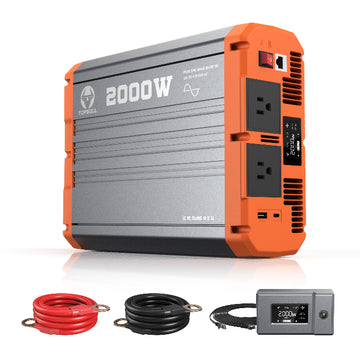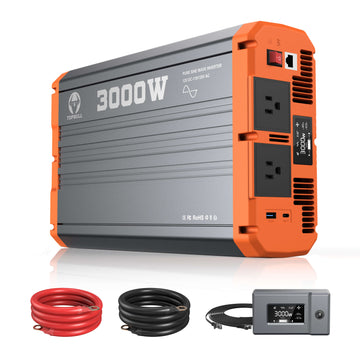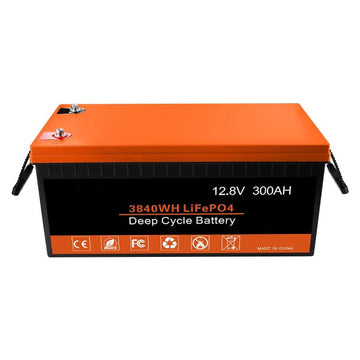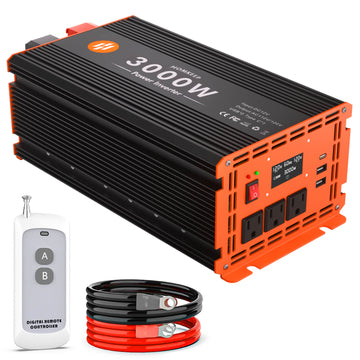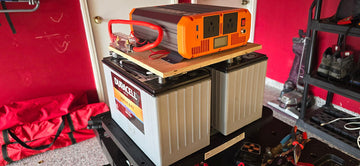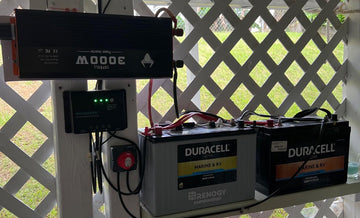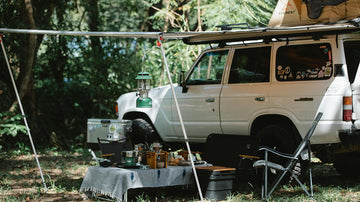In the daily use of inverters, one key factor is often overlooked: the ambient temperature. Whether you're in a hot desert or a cold winter, temperature has a direct impact on the efficiency of your inverter. In this article, we look at the challenges posed by ambient temperature and the measures that can be taken to protect system performance. Helping you make better decisions when selecting, installing, and maintaining your inverters - no matter how the weather changes.
Why inverter efficiency matters?
An inverter is a core component of an electrical system that converts DC power from a battery into AC power for household appliances. However, this conversion process is not 100 percent efficient, and some of this power is lost as heat. The efficiency of an inverter is the ratio of output power to input power, usually expressed as a percentage. The higher the efficiency, the less power is lost and the better the overall system performance.
In long-term operation, an efficient inverter means a higher financial return. On top of that, an inefficient inverter generates more heat, leading to accelerated aging of internal capacitors, switching tubes, and other components, shortening the life of the equipment. Choosing an inefficient inverter undoubtedly increases hidden maintenance and replacement costs. Especially in outdoor or high-temperature environments, the efficiency of the inverter is very important.

Effect of ambient temperature on inverter
Excessively high or low temperatures can have a direct impact on the conversion efficiency of an inverter. Especially in applications such as RVs, camping and hiking, inverters are often challenged by extreme weather conditions. Let's learn more about how temperature affects inverter efficiency.
How high temperatures affect inverter efficiency
High temperatures are one of the main factors for inverter efficiency degradation. When an inverter is in a high-temperature environment, its internal electronic components increase their conduction impedance due to the temperature rise, which leads to an increase in power loss. This additional resistance is converted into heat, exacerbating the device's heating, creating a vicious cycle.
To protect the internal components from overheating, many inverters are designed with Thermal Derating, which actively reduces the output power to lower the internal temperature when the ambient temperature exceeds safe operating limits. While this is a protective measure, it also means that the output power you get during the summer months may be significantly reduced.
In addition, prolonged exposure to high temperatures can accelerate wear and tear on critical inverter components and may even result in melted solder joints, warped circuit boards, or automatic inverter shutdown.
How low temperatures affect inverter efficiency
In addition to sustained high temperatures, the destructive power of low temperatures cannot be ignored. In extremely cold environments below -20°C, the electrical conductivity of the materials inside the inverter is significantly reduced, which affects energy transmission. In severe cases, it may not be possible to turn on the inverter.
In addition, at extreme low temperatures, the inverter housing material may shrink and the internal weld points or connectors become brittle and prone to cracking or loosening. This physical stress, which is repeated over and over again with the temperature difference between day and night, can create micro-damage inside the inverter, ultimately leading to system instability or sudden failure.
Minimize the effect of temperature on inverters
The inverter normally operates properly at ambient temperatures from 20°F to 104°F. However, to minimize the impact of ambient temperature on inverter efficiency, consider the following practices:
Choose an inverter with a wide temperature range
The most direct and effective way to get the most out of your battery is to choose an inverter that is adaptable and temperature tolerant, and Topbull has selected a wide range of high-performance battery inverters for outdoor, RV, and extreme weather applications. It supports -25°C to +60°C operation and has a built-in cooling fan. Whether you're running your system in the Texas summer heat or RVing in the middle of an Alaskan winter, these inverters provide consistent, reliable power output and minimize performance loss due to temperature fluctuations.
Hot Products: 2000W Pure Sine Wave Inverter

Installation location
The inverter should preferably be installed in a cool, ventilated environment to ensure sufficient space for air circulation around it. For outdoor installation, avoid exposing the device to direct sunlight, as sunlight exposure will significantly raise the temperature of the body. Installation under a roof is recommended.
In RV or small off-grid systems, the inverter should be installed in a well-ventilated area of the cabin, avoiding sharing a confined space with heat sources such as batteries, which can effectively prevent heat buildup.
Installation of heat dissipation equipment
If your system is in a hot area, consider installing an external fan for the inverter to enhance ventilation or using a mounting bracket with heat sinks or cooling fins. At the same time, you can arrange ventilation shutters or exhaust vents around the unit. These small investments can significantly reduce the temperature inside the unit and prevent the inverter from frequently derating.
Use insulation for cold environments
When installing the inverter in cold areas, you should wrap the unit with insulation or install it in a heated indoor space, such as a garage, tool room or indoor switchboard. If outdoor installation is necessary, it is recommended to add an electric heating film or heating pad that automatically heats up when the temperature gets too low.
Regular maintenance and monitoring
Preventive maintenance is the key to keeping your inverter efficient. You can check the operating temperature of the device in real time through the inverter's built-in monitoring system or external temperature sensors. Once the temperature exceeds the limit, timely troubleshooting the heat dissipation obstacles or adjusting the operating power can effectively avoid equipment overheating downtime or permanent damage.
At the same time, regularly clean the vents and heat sinks. Dust and debris buildup can impede airflow and increase the risk of overheating.
Other environmental factors to consider
In addition to temperature, inverters are affected by a variety of environmental factors in practice.
Humidity and water vapor
Humid environments, such as coastal areas or basements, can lead to condensation inside the inverter, which can lead to corrosion of circuits, short circuits or arcing failures. Humidity also creates an environment that promotes rust and deterioration of metal parts. Some inverters may trigger overload protection or automatic power failure due to degraded insulation.
Therefore, it is important to maintain air circulation around the inverter to avoid moisture buildup in enclosed spaces.
Dust and pollution
The cooling structures, fans and vents in the inverter are prone to dust accumulation. If left uncleaned for a long time, dust not only prevents heat dissipation and leads to overheating of the inverter, but also may enter the internal circuitry, causing static interference, electrical malfunctions, or degradation of insulation.
When operating in windy, sandy, construction site or vehicle environments, it is recommended to use inverters with dust filters and sealed housings, clean the unit's housing and vents regularly, and avoid installing the inverter close to the ground.
Exposure to corrosive chemicals
In industrial plants, chemical laboratories, battery storage rooms or coastal environments, inverters may be exposed to acid mist, salt spray or volatile chemical gases. These substances can cause galvanic corrosion of the inverter's internal circuit boards, solder joints and metal connections, which can lead to equipment malfunction and even obsolescence.
Especially in systems using lead-acid or lithium iron phosphate batteries, if the battery compartment is not sealed properly, electrolyte vapors or polar gases may also invade the inverter, causing long-term potential damage.
Therefore, avoid installing the inverter directly above the battery or in the area where the electrolyte evaporates, and use inverters with corrosion-resistant coatings and sealed housings.
Summary
As a key equipment in battery storage system or solar system, the efficiency of inverter is not only related to energy utilization, but also directly affects the stability and economy of the overall system. Under high temperature or cold environment, it may lead to the inverter's derating operation, increasing failure rate and even shortening its life span. By purchasing inverters with wide-temperature capability, together with scientific installation, good ventilation and environmental control, the operating efficiency can be significantly improved and the equipment life prolonged.

